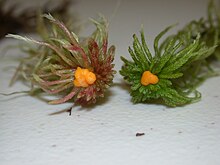Endogonales
| Endogonales | |
|---|---|

| |
| The fungus Endogone pisiformus | |
| Scientific classification | |
| Domain: | Eukaryota |
| Kingdom: | Fungi |
| Division: | Mucoromycota |
| Class: | Endogonomycetes |
| Order: | Endogonales Moreau ex R.K. Benj |
| Family: | Endogonaceae Paol. |
| Genera | |
|
See text | |
Endogonales is an order of fungi within the phylum of Zygomycota. It contains only one family, Endogonaceae, with four genera and 27 species.[1]
Life cycle
The life cycle of the Endogonales is distinguished by their production of small sporocarps containing many zygospores, which are eaten by rodents and distributed by their feces.
They also produce a fetid odor that attracts mammals and encourages them to eat their fruiting bodies, and so spread their spores.[2]
Food
Like all fungi, they are heterotrophs with some being described as saprobes (with weak evidence).[2]
References
Wikimedia Commons has media related to Endogonales.
Wikispecies has information related to Endogonales.
- ^ Kirk PM, Cannon PF, Minter DW, Stalpers JA (2008). Dictionary of the Fungi (10th ed.). Wallingford: CABI. p. 233. ISBN 978-0-85199-826-8.
- ^ a b C.J. Alexopolous, Charles W. Mims, M. Blackwell et al., Introductory Mycology, 4th ed. (John Wiley and Sons, Hoboken NJ, 2004) ISBN 0-471-52229-5
